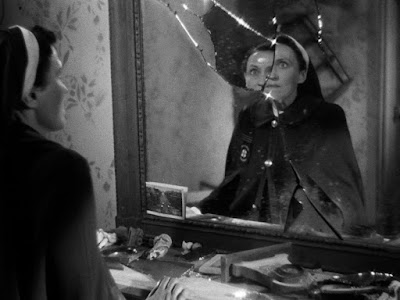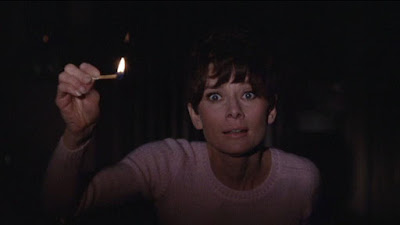Henri Georges Clouzot’s Occupation-era film, Le Corbeau (The Raven, 1943) although regarded as a masterpiece in the later decades, attracted lot of controversies in the immediate post-war period. Based on the scenario written by Louis Chavance, Le Corbeau is set in a small provincial French town isolated from the outside world. A climate of suspicion, paranoia, and denunciation plagues this town when a mysterious ‘poison-pen’ letter-writer starts a campaign of malicious finger-pointing. The narrative was based on a real event that happened in a small Southern France town (Tulle) between 1917 and 1922 (110 letters were anonymously sent). What sparked the controversy is the film’s allegorical treatment of the realities during the Nazi Occupation by portraying a community that’s about to implode and by focusing on a squalid bourgeoisie class. The scandal surrounding the film also included its depiction of illegal abortion and female sexuality.
After the fall of Vichy government in August 1944, Clouzot stood before Comite de Liberation du Cinema Francais (CLCF), which was formed to judge the film productions made during the Occupation. Mr. Clouzot was accused of directing a pro-Nazi anti-French movie (Jean-Paul Sartre, Marcel Carne, and Jean Cocteau came to Clouzot’s defense). In 1945, the director was condemned with a life-time ban, but a year later the sentence was reduced to two years (Clouzot returned to film-making in 1947). Clouzot continued to amalgamate suspense with atmosphere of horror in his later, much-heralded works including Wages of Fear (1953) and Les Diaboliques (1955).
Clouzot who did his film apprenticeship in Germany was inspired by the expressionist techniques of silent-era masters, F.W. Murnau and Fritz Lang. He mostly made his films – psychological thrillers tinged with horror – in black-and-white to retain the expressionist effects. Apart from the technical brilliance found in his films and the smooth flow of the narrative, Clouzot’s works are appreciated for the distant and neutral filmic gaze. The film-maker’s characters are pretty much flawed. But he offers an acute portrait of a society in which these characters live that it’s hard for us to direct a simple moralizing gaze at them.
Clouzot opens Le Corbeau by displaying a montage of grand Gothic buildings whose shadows are dispersed over the small-town, allowing only occasional bursts of sunlight (obviously a metaphorical representation of dark secrets and dishonesty). Such meticulous attention to mise-en-scene is followed by establishing the primary townspeople characters and their interpersonal relationships. The townspeople are haunted by ‘poison-pen’ letters sent to few chosen victims by someone signing ‘Raven’, revealing their alleged sexual indiscretions and long-held secrets. Instead of coming together to confront the menace of Raven (the town’s Id), the townspeople spread the web of gossip and use this as a campaign to root out ‘undesirable’ elements.
The Raven’s chief target happens to be Dr. Remy Germain (Pierre Fresnay), a prim gynecologist accused of being a abortionist and conducting an affair with his hospital supervisor’s young wife, Laura (Micheline Francey). The hospital supervisor, Dr. Vorzet (Pierre Larquey) is a psychologist and observes Raven’s accusations with an air of amusement. Dr. Vorzet also shares with his colleague Germain about his theories on who could be Raven and what propels him/her to do this. Much of the narrative spends time raising suspicion on its large cast of characters. The suspicion initially falls upon the hospital’s unlikable, remorseless head-nurse Marie Corbin (Helena Manson), Laura’s elder sister. When one of the terminal patients commits suicide after receiving a poison-pen letter the whole town decries against Ms. Corbin. Just when the people breathe a sigh of relief after Corbin’s arrest, the letters keep appearing, again squarely targeting Dr. Germain’s reputation. Finally, the chief suspects are rounded-up and are forced to take dictation (written in all-capital-letters like Raven’s letters).
Dr. Germain is an interesting choice for a protagonist, a man partly ignoble in his attitude that we don’t have much compassion to spare for him. Although the doctor’s tragic past provides us some answer to his cryptic behavior. Emotionally he is a very cold person, particularly the way he treats and perpetually judges Denise (Ginette Leclerc) – the object of his dispassionate love affair. The girl however is not fatally punished for her carnality, and in fact she is the most sympathetic character in the narrative. Germain’s misanthropy and utter disregard for others feelings is often pitted against the darkly humorous lectures of Dr. Vorzet.
In one of the film’s most acclaimed scene, Dr. Vorzet takes on the dichotomies existing in the society – light/dark, good/evil, guilt/innocence – by swinging a light bulb. To the uptight Germain, he argues how the boundaries of morality keep shifting (inside a individual or within a pressurized society). Despite such a unflinching portrayal of human pettiness, Le Corbeau takes a misstep by going for a neatly-packaged resolution. Clouzot definitely concocts supremely chilling shots for the denouement, yet the film’s ambiguous qualities are cast aside by a Hollywood-style ending.



